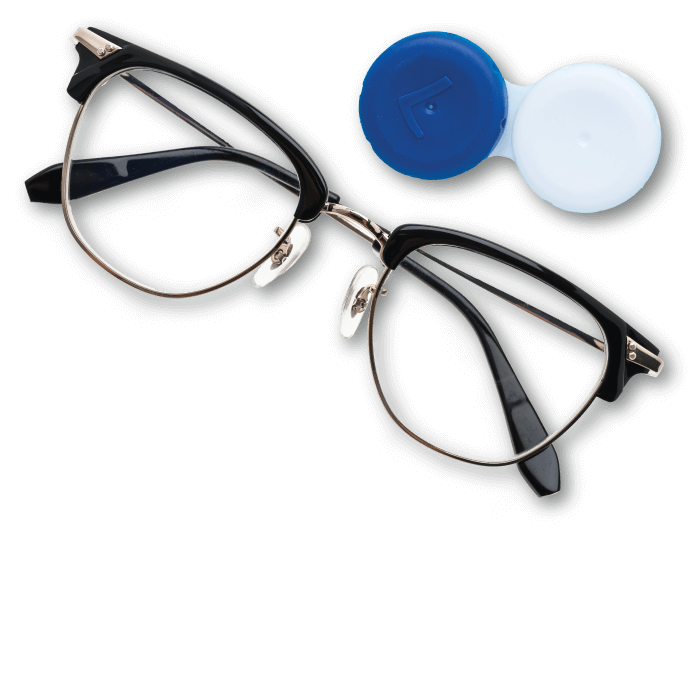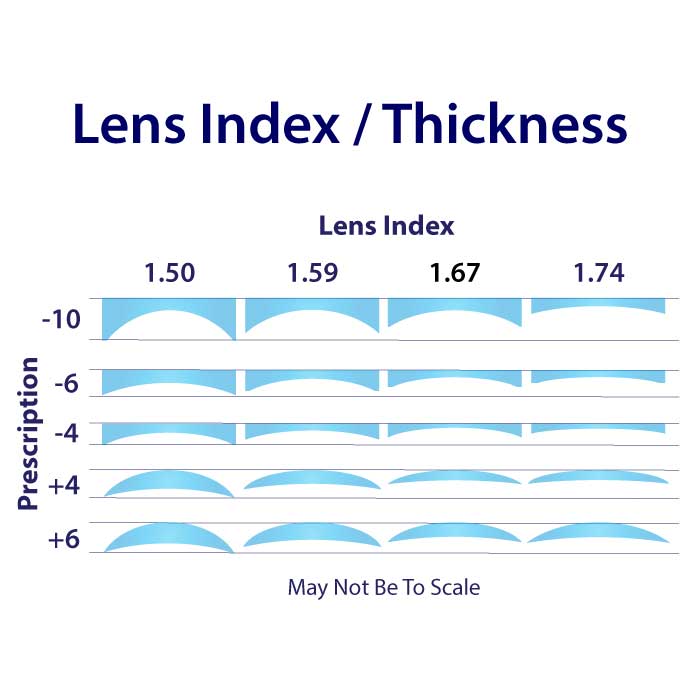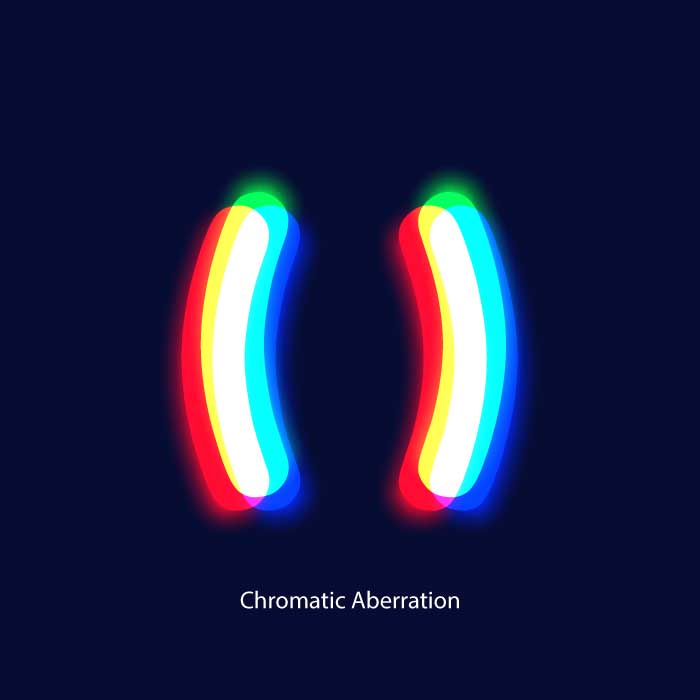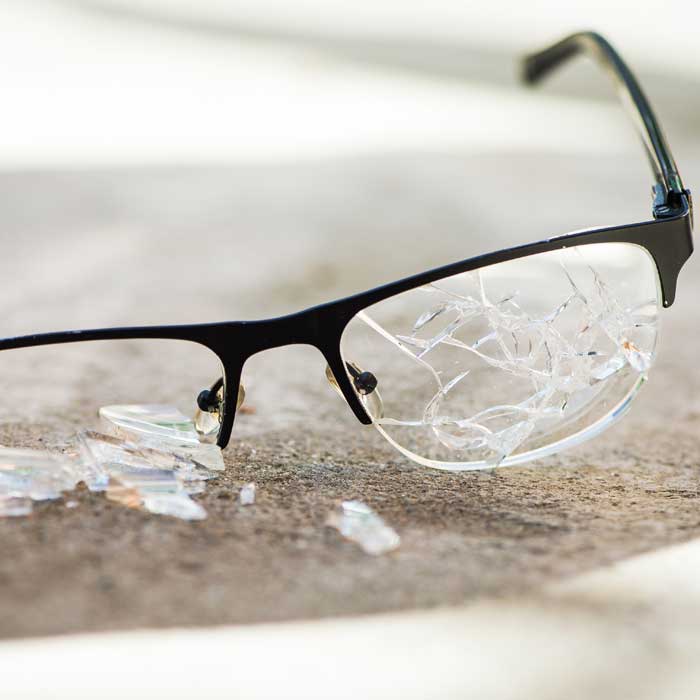
Refractive Index: A Way To Achieve Thin, Light Lenses
The refractive index of a prescription lens refers to its ability to bend light rays. As a general rule, the higher the prescription, the higher the index needed. Why? Because using standard index glass (index 1.52) or plastic (index 1.52) for high eyeglass prescriptions results in eyewear that is thick, heavy and aesthetically unflattering lenses. Fortunately, several "high-index" plastic lens materials that bend light more efficiently are available. eye-deology Vision Care offers plastic prescription lenses with refractive indexes from 1.50-1.74, providing the ability to keep eyewear comfortable and light. The clinic also provides access to a full range of indexes for Zeiss glass lenses.
Schedule An Exam Our Optometrists
(780) 473-6123
Refractive Index
High Index Lenses: Minimize Lens Thickness & Weight
High index lenses require less material to correct the same amount of refractive error, which means both thinner and lighter lenses. For nearsighted prescriptions, high index lenses result in noticeably thinner lens edges. For farsighted prescriptions, this means a noticeably reduced "Coke Bottle" effect. Also, for farsighted prescriptions, thinner aspheric lenses mean a minimized "bug-eye" look compared to what conventional index lenses produce. For individuals with stronger eyeglass prescriptions, high index lenses can improve both aesthetics and comfort. Our opticians are here to assist you in balancing form, function and price.
Schedule V-eye-P Eyewear Fitting
Refractive Index
High Index Lenses: Best With Anti-Reflection Coating
All lens materials block a portion of the light from passing through them. This light reflects from the lens surface, causing reflections, glare, and reduced night vision clarity. Conventional lenses (index 1.50) reflect approximately 8% of the light that should reach the eye. In comparison, high index lenses reflect up to 50% more light. As a result, an anti-reflective lens coating (AR coating) should be considered for high index lenses to experience the best vision and appearance. AR-coated eyeglass lenses allow 99.5% of light to reach the eye, thereby providing optimum vision and making lenses almost invisible. AR coatings also help minimize chromatic aberrations (see below).
Schedule V-eye-P Eyewear Fitting
Refractive Index
Light Dispersion: Abbe Values
A notable property of a prescription lens material is the Abbe value. This value measures the degree to which light is dispersed or separated when passing through the lens. Dispersion refers to when white light divides into its component colours. If the Abbe value is low, dispersed light will cause chromatic aberration to occur, which appears in one's vision to be like a rainbow around viewed objects especially noticed around light sources.
The higher the Abbe value, the better the peripheral optics will be. The lower the Abbe value, the more chromatic aberration will be a characteristic of that lens. Human eyes cannot detect chromatic aberration if the Abbe number is greater than 40. Low Abbe values can make for challenging night vision.
| Index | Manufacturer | Material | Abbe | Specific Gravity |
|---|---|---|---|---|
| 1.50 | All | Plastic (CR90) | 58 | 1.32 |
| 1.50 | Zeiss | Glass | 58 | 2.55 |
| 1.53 | Hoya | Trivex | 45 | 1.11 |
| 1.53 | Zeiss | Trivex | 45 | 1.11 |
| 1.53 | Essilor | Trivex | 43 | 1.11 |
| 1.56 | Essilor | Plastic | 37 | 1.36 |
| 1.56 | Hoya | Plastic | 41 | 1.20 |
| 1.59 | All | Polycarbonate | 30 | 1.21 |
| 1.60 | Essilor | Plastic | 36 | 1.34 |
| 1.60 | Hoya | Plastic | 42 | 1.34 |
| 1.60 | Varilux | Plastic | 36 | 1.34 |
| 1.60 | Zeiss | Glass | 44 | 2.67 |
| 1.66 | Optima | Plastic | 32 | 1.36 |
| 1.67 | Hoya | Plastic | 31 | 1.35 |
| 1.67 | Zeiss | Plastic | 32 | 1.35 |
| 1.67 | Essilor | Plastic | 32 | 1.35 |
| 1.70 | Hoya | Plastic | 36 | 1.41 |
| 1.70 | Zeiss | Glass | 39 | 3.19 |
| 1.74 | Essilor | Plastic | 33 | 1.46 |
| 1.80 | Zeiss | Glass | 34 | 3.65 |
| 1.90 | Zeiss | Glass | 30 | 4.02 |
Refractive Index
Different Indexes: Different Optical & Physical Attributes
Plastic lenses are available in refractive indexes ranging from 1.50 to 1.74. In most cases, individuals with higher prescriptions benefit from higher index lenses. Polycarbonate lenses (index 1.59), which are the primary lens index sold online and at big box stores, are often advertised as a great lightweight impact-resistant option. However, what is often never shared with patients is that it also possesses the worst (i.e., lowest) Abbe value amongst plastic lenses. Another disadvantage of polycarbonate is that it is a soft material, which causes it to scratch more easily. Accordingly, for the best vision and durability, polycarbonate lenses should be avoided for prescription eyeglasses, if possible. Instead, consider TRIVEX lenses (index 1.53) - they offer the same impact resistance as polycarbonate but possess a lower specific gravity and provide better optical performance.
Schedule V-eye-P Eyewear Fitting

Refractive Index
Balancing Act: Thickness, Weight & Optical Performance
Choosing the most suitable lens index requires one to factor for prescription, lens thinness, weight, optical performance, frame size, complementary lens coatings, and cost. For most individuals, this can be incredibly challenging and even overwhelming. eye-deology Vision Care licensed opticians to simplify the decision-making process by first identifying your priorities and needs and then presenting options that address them - outlining the differences and benefits of each. This approach ensures that patients make informed decisions about their eyewear purchases.
Schedule V-eye-P Eyewear Fitting
Refractive Index
Lens Materials: Plastic vs. Glass
Offering superb optical performance and exceptional scratch-resistance, you may wonder why glass lenses more uncommon than plastic eyeglass lenses. The five main reasons glass lenses less frequently used include:
- Weight. With a specific gravity 2-4 times greater than plastic, glass lenses are heavier, making long-term wear uncomfortable.
- Safety. Glass shatters and can represent a significant risk to vision. In terms of safety, plastic lenses are the better choice, especially for those with active lifestyles.
- Durability. The edges of glass lenses are more susceptible to chipping and cracking than plastic lenses. Replacement frequency may increase accordingly.
- Manufacturing Time. In general, it takes 2-3 times longer to manufacture glass lenses than plastic lenses.
- Cost. Glass lenses are considered special orders, and only a small number of manufacturers still craft glass lenses.

Our Edmonton Optometrists
Searching for an optometrist in Edmonton? Our experienced Edmonton eye doctors use advanced modern technologies and devote upwards of 500% more time towards providing personalized patient care than elsewhere so that they can see more and ensure that you may never see less. Position yourself to see the future with a visit to our eye clinic and Edmonton's best eye care!

Dr. Jennifer Ash, OD
Dr. Jennifer Ash is the Resident Optometrist at Eye-deology Vision Care. Dr. Ash provides patient care 5 days a week. Read more about Dr. Ash.

Dr. Ruhee Kurji, OD
Dr. Ruhee Kurji is an Associate Optometrist at Eye-deology Vision Care. Dr. Kurji provides patient care Tuesdays & Fridays. Read more about Dr. Kurji.

Dr. Jade McLachlin, OD
Dr. Jade McLachlin is an Associate Optometrist at Eye-deology Vision Care. Dr. McLachlin provides patient care 5 days a week. Read more about Dr. McLachlin.
Learn Why Our Edmonton Optometrists Are The Best!


